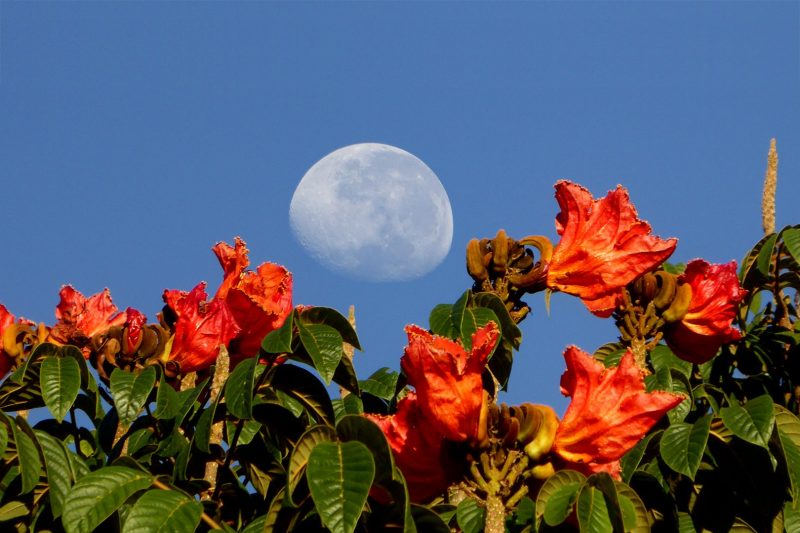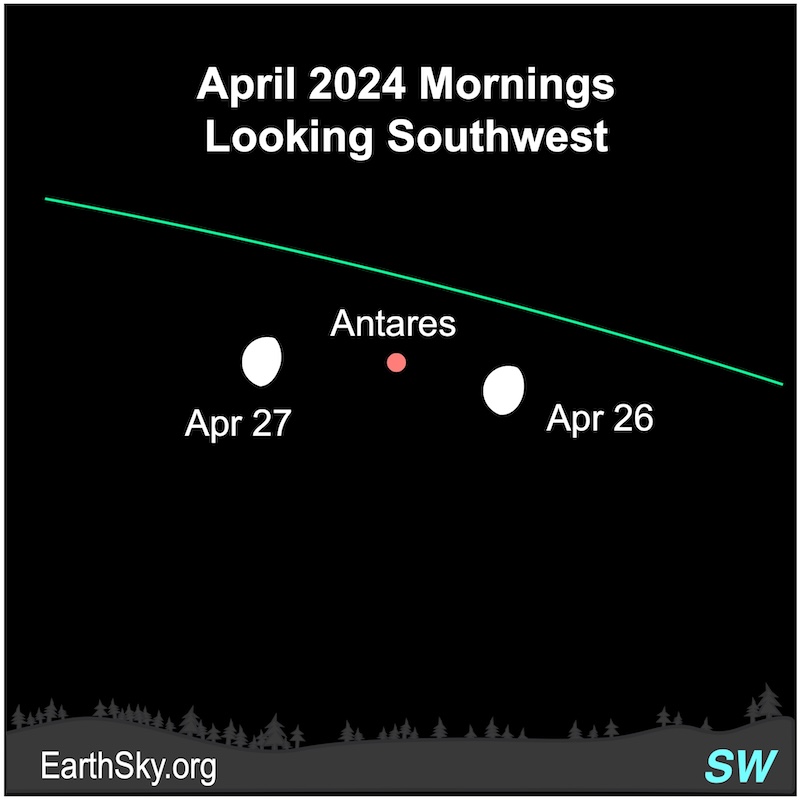Watch For a Daytime Moon
Peter Lowenstein caught the daytime moon in its waning gibbous phase from Mutare, Zimbabwe. He said: “Three-quarters of an hour after sunrise, I photographed the daytime moon descending toward the top of a flowering African Tulip (Spathodia campanulta) tree.”
Daytime moon is up after sunrise now
This month’s full moon came on the night of April 23, 2024. By April 25, the moon is in a waning gibbous phase, rising later and later each successive night. For those at temperate latitudes in the Northern Hemisphere, there’s an especially long time between moonrises on successive evenings around now. The April 25 moon will rise more than two hours after sunset. The April 26 moon will rise roughly to three hours after sunset.
And, of course, a later rising time means a later setting time. That’s why the mornings after a full moon are a good time to catch a nearly full daytime moon over your western horizon after sunrise.
The moon is up in the daytime half of the time. But, because it’s pale against the blue sky, it’s not as noticeable during the day as at night. Still, there are certain windows each month during which the daytime moon is most noticeable. The rest of April 2024 presents one of those windows, a good time to watch for a daytime moon.
April 26 and 27 Mornings, Moon Near Antares
By the mornings of April 26 and 27, 2024 (or late evening April 25 and 26), the moon will be near the bright star Antares in the constellation Scorpius the Scorpion. At that time, the moon will be rising a little before midnight at mid-northern latitudes. And it’ll still be up after the sun rises, but appearing thinner in phase and higher in the sky with each new dawn.
Because of Earth’s motion around the sun, Antares – like all the fixed stars (stars that appear not to move relative to one another) – will rise about four minutes earlier each evening. Meanwhile, because of its own motion around Earth, the moon will be rising later and later each evening and thus moving away from Antares’ location in the sky.
Published 24th April 2024 – Earthsky.org
https://earthsky.org/tonight/see-the-daytime-moon/
- Home
- Forum
- Chat
- Donate
- What's New?
-
Site Links

-
Avalon Library

-
External Sites

- Solari Report | Catherine Austin Fitts
- The Wall Will Fall | Vanessa Beeley
- Unsafe Space | Keri Smith
- Giza Death Star | Joseph P. Farrell
- The Last American Vagabond
- Caitlin Johnstone
- John Pilger
- Voltaire Network
- Suspicious Observers
- Peak Prosperity | Chris Martenson
- Dark Journalist
- The Black Vault
- Global Research | Michael Chossudovsky
- Corbett Report
- Infowars
- Natural News
- Ice Age Farmer
- Dr. Joseph Mercola
- Childrens Health Defense
- Geoengineering Watch | Dane Wigington
- Truthstream Media
- Unlimited Hangout | Whitney Webb
- Wikileaks index
- Vaccine Impact
- Eva Bartlett (In Gaza blog)
- Scott Ritter
- Redacted (Natalie & Clayton Morris)
- Judging Freedom (Andrew Napolitano)
- Alexander Mercouris
- The Duran
- Simplicius The Thinker








 Reply With Quote
Reply With Quote

Bookmarks